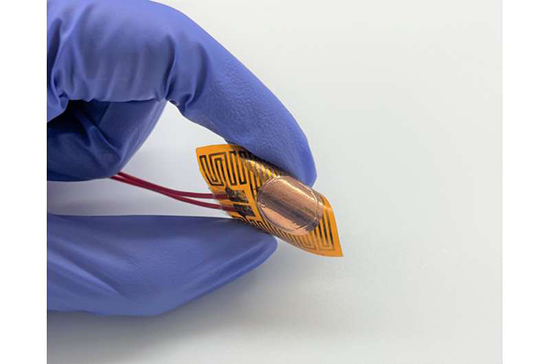Significance
As technology has advanced, devices have become smaller and more powerful. However, this has also led to an increase in the risk of overheating and burning out. Despite advancements in cooling solutions, the interface between an electronic chip and its cooling system has remained a barrier for thermal transport due to the materials’ intrinsic roughness.
Graphene-nanowire flexible electronics are a promising technology that can have a wide range of applications in various engineering fields. Due to their unique properties, such as high mechanical flexibility, high thermal conductivity, high electrical conductivity, and optical transparency, these materials have the potential to revolutionize the way we think about electronics. One of the most promising applications of graphene-nanowire flexible electronics is in wearable sensors for healthcare and fitness monitoring. By integrating sensors into clothing or wearable devices, patients and athletes can monitor their vital signs and performance in real-time, allowing for early detection of potential health issues and optimizing their training regimes. For example, a graphene-nanowire sensor integrated into a shirt can monitor heart rate, respiratory rate, and temperature, providing valuable information to healthcare professionals and coaches. Another potential application is in flexible displays and lighting. Graphene-nanowire-based LEDs and lasers can be used in lighting and display applications, providing a high-quality, energy-efficient solution. Due to their mechanical flexibility, these displays can be rolled up or folded, making them ideal for use in wearable devices or portable electronics.
Implantable electronics for monitoring health and imaging are also a promising application for graphene-nanowire flexible electronics. By integrating sensors and imaging technology into implants, doctors can monitor patients’ health and detect potential issues before they become serious. For example, a graphene-nanowire-based sensor could be integrated into a pacemaker to monitor heart activity, providing valuable data for healthcare professionals. Soft robotics is another field that can benefit from the use of graphene-nanowire flexible electronics. By integrating these materials into soft robots, engineers can create robots that can bend, stretch, and twist, making them ideal for use in applications such as search and rescue missions, exploration of hazardous environments, and medical devices.
Sheng Shen, Professor in the Department of Mechanical Engineering at Carnegie Mellon University, has developed a flexible, powerful, and highly reliable material that can efficiently fill the gap. This material is composed of two thin copper films with a graphene-coated copper nanowire array sandwiched between them. At first glance, the material looks like any ordinary copper film, but under a microscope, the novelty of the material becomes clear.
The “sandwich” is built using Shen’s “supersolder,” a thermal interface material (TIM) that can be used similarly to conventional solders but has twice the thermal conductance of current state-of-the-art TIMs. By coating the “supersolder” in graphene, Shen’s team has enhanced its thermal transport capabilities and prevented the risk of oxidation, ensuring a longer service life. The “sandwich” reduces thermal resistance by more than 90% compared to the thermal pastes/adhesives currently on the market when considering the same thickness.
Moreover, the “sandwich” is ultra-highly flexible and can enable a wide range of applications in flexible electronics and microelectronics. It can be used in flexible LEDs and lasers for lighting and display, wearable sensors for communication, implantable electronics for monitoring health and imaging, and soft robotics. The research team will explore ways to scale the material at an industrial level, lower its cost, and continue to improve it. They are excited about the material’s potential and believe that a wide variety of electronic systems can benefit from it by allowing them to operate at a lower temperature with higher performance.
The importance of this research cannot be overstated. As electronic devices get smaller and more powerful, the need for better cooling solutions becomes more pressing. The use of this new material can improve the thermal transfer between the device and the cooling system and thereby increase the performance and longevity of electronic devices. Moreover, the flexibility of the material opens up new avenues for its application in various fields such as flexible electronics, implantable electronics, and soft robotics. The ability to cut the material to any size or shape without depending on any substrate makes it extremely user-friendly and cost-effective.
Graphene-nanowire flexible electronics have the potential to transform the way we think about electronics and their applications in engineering. With continued research and development, these materials can be integrated into a wide range of devices, from wearables to implants to soft robots, providing high-quality, energy-efficient solutions that can improve our lives and make the world a better place. The development of this new material can have a significant impact on the electronics industry. It can lead to the creation of more efficient and reliable electronic devices with longer service lives, thus reducing the environmental impact of electronic waste.

Reference
Jing L, Cheng R, Garg R, Gong W, Lee I, Schmit A, Cohen-Karni T, Zhang X, Shen S. 3D Graphene-Nanowire “Sandwich” Thermal Interface with Ultralow Resistance and Stiffness. ACS Nano. 2023 Feb 14;17(3):2602-2610. doi: 10.1021/acsnano.2c10525.
 Advances in Engineering Advances in Engineering features breaking research judged by Advances in Engineering advisory team to be of key importance in the Engineering field. Papers are selected from over 10,000 published each week from most peer reviewed journals.
Advances in Engineering Advances in Engineering features breaking research judged by Advances in Engineering advisory team to be of key importance in the Engineering field. Papers are selected from over 10,000 published each week from most peer reviewed journals.

